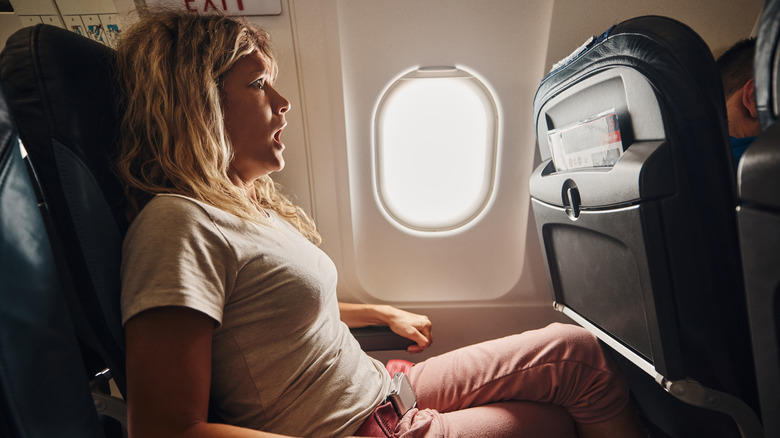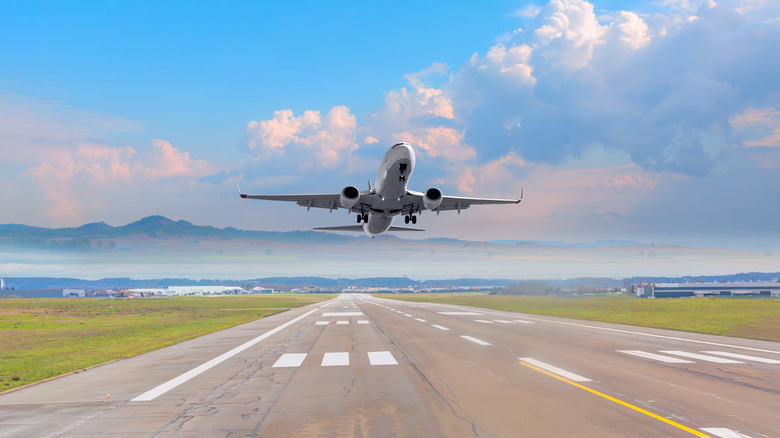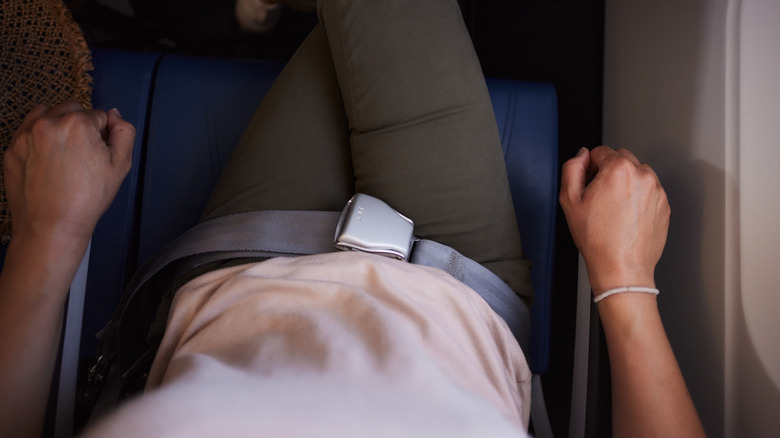This Is Why Planes 'Dip' And Give You A Terrifying Sinking Feeling Right After Takeoff
You're on a plane that's just taken off, and you look out the window to see the cars and trees on the ground become smaller and smaller. As you continue climbing farther up in the sky, all of a sudden you feel the aircraft dip, as if it's about to fall back down to Earth. You may have noticed this phenomenon on several flights, and even if you've come to expect it by now, that sinking feeling can still trigger flying anxiety.
In a viral TikTok, airline pilot @jimmy_nicholson explains this post-takeoff dip in detail. First, the flying expert shares that the plane will usually maintain a high speed during takeoff until it reaches a safe altitude. This can happen quickly if the aircraft ascends at a steep angle. Once the plane has reached a certain altitude, the pilots reduce the thrust, or the power needed to keep the plane going. When this thrust is reduced, the plane can often feel as if it's dropping, as it stabilizes at cruising altitude and speed.
@jimmy_nicholson Replying to @alexdyaz4895 Aeroplanes falling out of the sky on takeoff. Why does it feel like the plane is falling? #pilotsoftiktok #pilot #piloto #turbulence #pilottok
According to @jimmy_nicholson, you might also feel a sinking feeling when the flaps and slats on the wings are retracted. Like the thrust, these are adjusted once the plane reaches a certain altitude and the additional wing surface area is no longer needed. This levels the plane's ascent, making it feel like you're falling.
One reason for the sensation is noise reduction
In a separate TikTok clip, aviation expert @dial_a_pilot elaborates on the post-takeoff dip. In the video, the pilot explains that the reduction of the thrust is especially pronounced on flights where noise reduction measures are in place. Takeoff can be noisy, and for the people who live near airports, the noise pollution can cause disturbances at all hours of the day. A 2017 research report published in the journal Noise & Health determined that aviation noise is linked to poor cognition in children, sleep issues, and other health conditions.
In some areas, planes are required to lower the thrust shortly after takeoff to keep noise to a minimum. This mitigates the negative impacts of noise pollution on those who reside in the flight path below. In his TikTok video, @dial_a_pilot notes that this is common at airports such as John Wayne Airport, the best airport for Disneyland travelers. Some types of aircraft may also be noisier than others, meaning they're more likely to have to "dip" after takeoff.
Should you worry about that sinking feeling?
The dip you feel after your plane takes off can make you wonder if the plane is about to nosedive. Even if it makes your stomach drop, the sensation is completely normal and nothing to fear. In fact, the plane isn't even dropping after the thrust and wings have been adjusted, despite the feeling. When the thrust is lowered and the wing flaps are retracted, the plane slows, which can feel like a dip to the passengers on board. In reality, the aircraft is still continuing the climb — just not as rapidly or steeply as it had been. Essentially, your body is simply playing catch up to the plane's change in momentum.
With this in mind, there's no need to worry if you notice the plane "sinking" shortly after leaving the runway. Know that the sensation is just part of the pilot's usual routine, not a mishap or plane crash waiting to happen. If the dip still makes you nervous, consider borrowing our psychologist's best tips to overcome your fear of flying.


